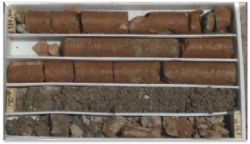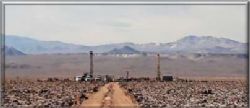
Drilling Confirms Large Scale Lithium Brine Basin Kachi Lithium Project, Argentina
Brisbane, May 22, 2018 AEST (ABN Newswire) - Argentine-focused lithium exploration and project development company Lake Resources NL ( ASX:LKE) is pleased to report initial drill results and ongoing exploration activities at its 100%-owned Kachi Lithium Brine Project in Catamarca Province.
ASX:LKE) is pleased to report initial drill results and ongoing exploration activities at its 100%-owned Kachi Lithium Brine Project in Catamarca Province.
- Initial drilling confirms the Kachi Lithium Project is a maiden discovery of a very large deep lithium brine-bearing basin being a similar size to producing globally significant lithium projects.
- Lithium brines intersected in numerous horizons from surface to 400metres in drill holes spaced 11 kilometres apart at Lake's 100%-owned Kachi Lithium Brine Project in Catamarca Province, Argentina.
- Seven rotary and diamond drill holes completed in lithium brine-bearing sediments in the Kachi salt lake. Results reported for four of the seven new resource drill-holes, with variable depths up to 402 metres.
- Highlights include drill-hole PP2-DV-003, which averaged 308mg/l lithium after 27 hours of airlifting, with low impurities and low average Mg/Li ratio of 4.3.
- Results are pending from a number of samples from depths below 200 metres with promising conductivities.
- Six of the seven holes ended in sandy material, and remain open at depth. The extensive sands encountered have relatively high drainable porosity based on initial site observations, and are expected to have relatively high permeability, positive for future brine extraction requirements and resource estimation.
- Lake considers the Kachi project to be a covered salt lake over 25 x 15 kilometres hosting a very large lithium brine body in sandy sediments with high permeability and low impurities.
- A seismic survey and drilling data suggests the Kachi basin is over 400 metres deep with potential to host a very significant volume of brine. This vindicates the exploration approach, despite slow drilling and delays in results.
- Deeper horizons are being targeted to locate higher grades and assess flow rates and extend the potential. The implied size of the brine reservoir has made the Company contemplate further drilling rigs to accelerate the resource assessment.
The Company can now definitively demonstrate that lithium brine is present in numerous horizons from near surface to at least 400m depth in drill holes spaced 11km apart (see Figure 1 in link below). Drilling also confirms Kachi is a very large-scale covered salt lake over an area of around 25 x 15 kilometres (375 km2).
Lake has been conducting two concurrent phases of drilling operations:
1. Resource exploration drilling utilising a diamond drill rig to collect drill cores for porosity assessment and to obtain brine samples for resource estimation, and
2. Production well drilling using rotary drill rigs for additional resource estimation data and construction of wells for test pumping purposes. These will have the potential to pump lithium brine into trial evaporation ponds and test the latest extraction methods. A total of seven drill holes have been completed on three separate drill platform locations (see Figure 1 in link below).
Lake's Managing Director, Steve Promnitz, commented "The significant scale of the Kachi basin is evident. We believe that there is a covered salt lake with an estimated area over 25 x 15 kilometres, hosting a very large brine body in sandy sediments with good permeability and low impurities.
Drilling has intersected multiple brine aquifers. The higher lithium values with a low Mg/Li ratio in hole- 003 area positive discovery and indicate good potential for future positive results. Three drill rigs are on site in the expanded drill programme to accelerate exploration to produce a resource statement."
Resource Drilling - Kachi Lithium Brine Project
Lake Resources' 100%-owned Kachi Lithium Brine Project in Catamarca province, Argentina covers over 50,000 hectares of mining leases owned 100% by Lake's Argentine subsidiary, Morena del Valle Minerals SA. These are held over the centre of the known Kachi salt lake in the deepest part of the basin. Surface sampling has revealed positive lithium results in conductive brines, which are being quantified through the drilling program and geophysics.
The current status of resource diamond drilling works comprises the completion of four diamond drillholes, with the receipt of analytical results from brine samples from the first three drill-holes. Table 1 (see link below) provides drill hole location details and averaged lithium results. Three rotary wells have also been drilled to date with more underway.
Completed diamond drill holes were progressively drilled deeper as drilling knowledge has been gained. Within the lake, variable lithologies have been intersected which are dominated by sandy sediments. Samples have been collected for porosity measurements that will be undertaken by a laboratory in the USA with extensive experience in analysing salt lake sediments for their porosity characteristics, in particular the specific yield for drainable porosity. Once completed, the porosity data will be used together with the systematic brine analyses from the drilling samples to produce a resource estimate in accordance with the JORC reporting code.
Analytical results for lithium to date have been highest in drill-hole PP2-DV-003. Brine samples in this hole display encouraging conductivities and densities with a favourable Li/Mg ratio of 4.3.
The diamond drilling intersected thick intervals of intercalated sands, gravels, sandy clays and clay horizons. The predominant litho-type of lake sediments is sand-dominant, and poorly consolidated, with relatively low core recoveries in sandy material. Figure 2 (see link below) shows a range of grain sizes in material from drill site JV006 (in the south) within unconsolidated sediments found to 300m depth.
Initial indications from field hydraulic testing indicate high permeabilities for the sandy material, which will be further tested with the installation of large diameter production test bores.
The deepest drilling to date at 402m has been undertaken in the south of the project area in diamond drill hole PP2 at site JV006 (see Figure 1 in link below). Here approximately 300m of almost continuous, predominantly sandy sediments have been intersected as well as two ignimbrites. An ignimbritic breccia was encountered below 300m, underlain by a sedimentary conglomerate (see Figure 3 in link below) containing brines with encouraging densities and conductivities and iron staining which suggests secondary permeability features. The seismic geophysical program identified the ignimbritic breccia horizon which shows considerable extent in the basin.
Brine Chemistry
Brines with high conductivity and density (1.18 - 1.22 g/cm3) have been intersected in thick sandy and gravelly aquifers, with the best results to date 308 mg/L after 27 hours of airlifting from 200m depth in hole PB1-JV003. A number of samples are pending from greater depths to 400m, where the brine has promising elevated conductivities and densities. Pump testing will occur in the near future as the rotary rig completes replication of the diamond drilling in larger diameter holes, allowing the installation of test production wells. Regular updates will be provided in future as drilling progresses. To date the lithium brines analysed show positive chemistry with low combined impurities (boron, sulphate, calcium, magnesium, iron). Brines pending analysis from deeper levels (350 - 400m) in JV006 also show high density (1.2 g/cm3). Deeper horizons are being targeted to locate higher grades and extend the potential size of the brine mineralisation. The suggested size of the brine body has made the Company contemplate further drilling rigs to accelerate the resource statement.
Production Well Drilling
The Company has recently completed three rotary drill-holes. One of which will be used as an aquifer test well to better understand hydraulic properties. This first production well is located at site JV006 in the south, and diamond drill-holes at this site will act as monitoring wells. The production well is installed with 6-inch PVC casing and screens in the hole drilled at a 9.5-inch diameter. A rotary drill hole was also drilled at JV003 in the west, to a depth of 242m (PP2-DV-003). Brine in the hole was air lifted which returned a lithium grade of 308 mg/L lithium following a period of 27 hours, , with an average Mg/Li ratio of 4.3. These grades are significantly higher than recorded from shallower levels at the same location, and the airlift sample at 30 minutes is interpreted to include contributions from shallower levels.
Geophysical Survey
A geophysical seismic survey is being undertaken using passive seismic techniques, with the aim of developing an understanding of basin geometry and thickness of the sediments hosting brine. This method distinguishes lithologies with highly contrasting seismic velocities such as unconsolidated lake sediments and harder cemented sediments or ignimbrites. To date 170 stations have been processed.
The results correlate well with dense lithologies intersected at 300m depth in PP2-JV003 in the south, and suggest the presence of unconsolidated sediments to a depth in excess of 500m under gravel cover. The survey suggested the majority of the basaltic material visible at surface is a thin veneer overlying lake sediments, which is very positive for the project as it increases the potential volume of sediments to host brines.
To view tables and figures, please visit:
http://abnnewswire.net/lnk/PGYHMTL6
About Lake Resources NL
 Lake Resources NL (ASX:LKE) (OTCMKTS:LLKKF) is a clean lithium developer utilising state-of-the-art ion exchange extraction technology for production of sustainable, high purity lithium from its flagship Kachi Project in Catamarca Province within the Lithium Triangle in Argentina among three other projects covering 220,000 ha.
Lake Resources NL (ASX:LKE) (OTCMKTS:LLKKF) is a clean lithium developer utilising state-of-the-art ion exchange extraction technology for production of sustainable, high purity lithium from its flagship Kachi Project in Catamarca Province within the Lithium Triangle in Argentina among three other projects covering 220,000 ha.
This ion exchange extraction technology delivers a solution for two rising demands - high purity battery materials to avoid performance issues, and more sustainable, responsibly sourced materials with low carbon footprint and significant ESG benefits.
| ||
|















